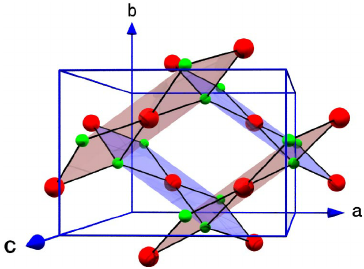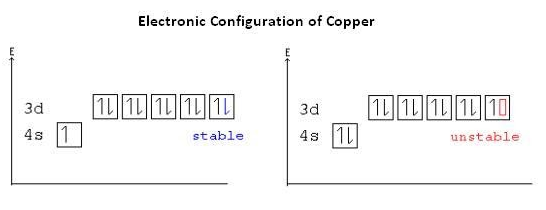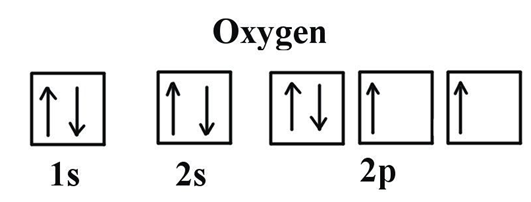
Colour of CuO is
A. Black
B. Blue
C. Green
D. Red
Answer
138.9k+ views
Hint: In order to answer the question , we need to have a detailed idea about the structure of CuO. We should also be familiar with the physical and chemical properties of CuO.
Complete step-by-step answer:
Let us have a look into the structure of CuO.
The red structures are the Copper atoms and the green structures are the oxygen atoms.
The atomic number of copper is 29. And that of oxygen is 8.
So the electronic configurations of both the elements are given below:


The main factor to occur the colour of the compounds of d block, is having the d orbitals with an incomplete electron filling in the middle atom.
There is an inequality of energy, among those d orbitals. Therefore d-d electrons exchange among those orbitals by absorbing energy. The amount of energy consumption causes the colour of the compound. Here, different amounts of energy need to exchange different numbers of electrons. Thereby the wavelengths absorbed in the process changes, and consequently different colours occur.
The colour of CuO is known to be Black. So the correct option is Option A.
Note: We should be knowing the few uses of CuO. So here are some uses of CuO listed below:
Used in the welding process along with various copper alloys.
Used as a precursor in various copper containing products like wood preservatives and ceramics.
Some properties of CuO are:
Super Thermal Conductivity.
CuO shows photovoltaic properties.
It has high stability and high antimicrobial activity.
Complete step-by-step answer:
Let us have a look into the structure of CuO.

The red structures are the Copper atoms and the green structures are the oxygen atoms.
The atomic number of copper is 29. And that of oxygen is 8.
So the electronic configurations of both the elements are given below:


The main factor to occur the colour of the compounds of d block, is having the d orbitals with an incomplete electron filling in the middle atom.
There is an inequality of energy, among those d orbitals. Therefore d-d electrons exchange among those orbitals by absorbing energy. The amount of energy consumption causes the colour of the compound. Here, different amounts of energy need to exchange different numbers of electrons. Thereby the wavelengths absorbed in the process changes, and consequently different colours occur.
The colour of CuO is known to be Black. So the correct option is Option A.
Note: We should be knowing the few uses of CuO. So here are some uses of CuO listed below:
Used in the welding process along with various copper alloys.
Used as a precursor in various copper containing products like wood preservatives and ceramics.
Some properties of CuO are:
Super Thermal Conductivity.
CuO shows photovoltaic properties.
It has high stability and high antimicrobial activity.
Recently Updated Pages
How to find Oxidation Number - Important Concepts for JEE

How Electromagnetic Waves are Formed - Important Concepts for JEE

Electrical Resistance - Important Concepts and Tips for JEE

Average Atomic Mass - Important Concepts and Tips for JEE

Chemical Equation - Important Concepts and Tips for JEE

Concept of CP and CV of Gas - Important Concepts and Tips for JEE

Trending doubts
JEE Main 2025 Session 2: Application Form (Out), Exam Dates (Released), Eligibility, & More

JEE Main 2025: Derivation of Equation of Trajectory in Physics

Learn About Angle Of Deviation In Prism: JEE Main Physics 2025

Number of sigma and pi bonds in C2 molecule isare A class 11 chemistry JEE_Main

Electric Field Due to Uniformly Charged Ring for JEE Main 2025 - Formula and Derivation

JEE Main 2025: Conversion of Galvanometer Into Ammeter And Voltmeter in Physics

Other Pages
NCERT Solutions for Class 11 Chemistry Chapter 9 Hydrocarbons

NCERT Solutions for Class 11 Chemistry Chapter 7 Redox Reaction

JEE Advanced Marks vs Ranks 2025: Understanding Category-wise Qualifying Marks and Previous Year Cut-offs

NCERT Solutions for Class 11 Chemistry Chapter 5 Thermodynamics

Hydrocarbons Class 11 Notes: CBSE Chemistry Chapter 9

NCERT Solutions for Class 11 Chemistry In Hindi Chapter 1 Some Basic Concepts of Chemistry




